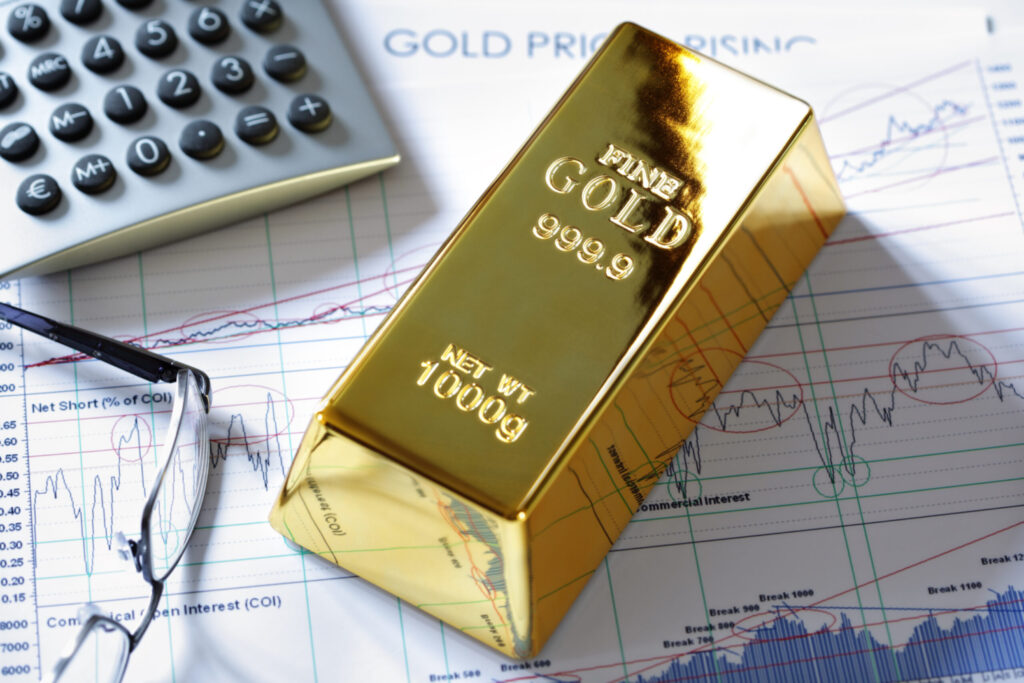
Gold ingot resting on a stocks and shares graph representing investment or banking
DUBLIN–(BUSINESS WIRE)–Nov 21, 2022–
The “Gold Nanoparticles Market Size, Share, Trends, By Type, By End-use, By Application, and By Region Forecast to 2030” report has been added to ResearchAndMarkets.com’s offering.
The gold nanoparticles market is forecast to reach USD 8.3 Billion by 2030, according to a new report. Gold nanoparticles are particles with diameters in the order of a few nanometers.
Companies Mentioned
- Cytodiagnostics Inc.
- Goldsol Inc.
- BBI Solutions
- NanoHybrids
- Torskal
- Nanosphere Inc.
- TANAKA Holdings Co. Ltd.
- Cline Scientific
- Meliorum Technologies Inc.
- NanoComposix
- Abcam plc.
- Agilent Technologies Inc.
They possess unique optical and physical properties that make them useful in a variety of applications such as nanomedicine, cancer therapy, and electronics. The rising demand for gold nanoparticles in these applications is expected to drive market growth over the forecast period.
The increasing use of gold nanoparticles in cancer therapy is a key factor driving the market growth. Gold nanoparticles can be used in cancer therapy either as a diagnostic tool or as a treatment. They can be used to target and destroy cancer cells while leaving healthy cells unharmed. This makes them an attractive option for cancer treatment.
The rising demand for gold nanoparticles in nanomedicine. Nanomedicine is the application of nanotechnology to the field of medicine. It holds great promise for the early detection and treatment of diseases. Gold nanoparticles can be used in nanomedicine to target and destroy diseased cells while leaving healthy cells unharmed. This makes them an attractive option for the early detection and treatment of diseases.
Gold nanoparticles in electronics is another key factor driving the market growth. Gold nanoparticles can be used to create miniature electronic devices with enhanced functionality. They can also be used to create conductive coatings that can improve the performance of electronic devices. The rising demand for gold nanoparticles in these applications is expected to drive market growth over the forecast period.
Gold nanoparticles can be used in cosmetics to create anti-aging products. They can also be used to create products that can improve the appearance of the skin. The rising demand for gold nanoparticles in these applications is expected to drive market growth over the forecast period.
Gold nanoparticles are known to be toxic to the human body. They can cause DNA damage and cell death. Therefore, their use is regulated by various government agencies. This is expected to restrain market growth over the forecast period.
Further key findings from the report suggest
- On the basis of type, the gold nanoparticles market has been segmented into nanospheres, nanorods, nanocubes, and nanotriangles. The nanospheres segment accounted for the largest market share in 2017 and is projected to grow at the highest CAGR from 2018 to 2023. This growth can be attributed to their higher stability compared to other types of gold nanoparticles, which makes them more suitable for use in a wide range of applications.
- On the basis of application, the gold nanoparticles market has been segmented into nanomedicine, cancer therapy, electronics, cosmetics, and others. The nanomedicine segment accounted for the largest market share in 2017 and is projected to grow at the highest CAGR from 2018 to 2023. The large share of this segment can be attributed to the rising demand for gold nanoparticles in drug delivery, imaging, and diagnostics applications.
- On the basis of the end-use industry, the gold nanoparticles market has been segmented into healthcare, electronics, cosmetics, and others. The healthcare industry accounted for the largest share of the gold nanoparticles market in 2017 and is expected to grow at the highest CAGR from 2018 to 2023. The large share of this segment can be attributed to the growing use of gold nanoparticles in nanomedicine applications such as drug delivery, cancer therapy, and diagnostics.
- On the basis of geography, the gold nanoparticles market has been segmented into North America, Europe, Asia Pacific, and the Rest of the World (RoW). North America accounted for the largest share of the global market in 2017. The large share of this region can be attributed to the presence of a large number of key players in the region and the growing demand for gold nanoparticles in nanomedicine and cosmetics applications.
For the purpose of this report, the author has segmented the global gold nanoparticles market on the basis of type, applications, end-users, and region:
Type Outlook (Revenue, USD Billion; 2019-2030)
- Nanorods
- Nanoshells
- Nanocages
- Others
Application Outlook (Revenue, USD Billion; 2019-2030)
- Imaging
- Targeted Drug Delivery
- Sensors
- In Vitro Diagnostics
- Probes
- Catalysts
- Others
End-use Outlook (Revenue, USD Billion; 2019-2030)
- Electronics
- Healthcare
- Chemicals
- Cosmetics & Personal Care
- Others
Regional Outlook (Revenue, USD Billion; 2019-2030)
- North America
- U.S.
- Canada
- Mexico
- Europe
- Germany
- U.K.
- France
- Italy
- Spain
- Sweden
- BENELUX
- Rest of Europe
- Asia-Pacific
- China
- India
- Japan
- South Korea
- Rest of APAC
- Latin America
- Brazil
- Rest of LATAM
- Middle East & Africa
- Saudi Arabia
- UAE
- South Africa
- Israel
- Rest of MEA
For more information about this report.
View the source version on businesswire.com
CONTACT: ResearchAndMarkets.com
Laura Wood, Senior Press Manager
press@researchandmarkets.com
For E.S.T Office Hours Call 1-917-300-0470
For U.S./ CAN Toll-Free Call 1-800-526-8630
For GMT Office Hours Call +353-1-416-8900
KEYWORD:
INDUSTRY KEYWORD: TECHNOLOGY NANOTECHNOLOGY
SOURCE: Research and Markets
Copyright Business Wire 2022.
PUB: 11/21/2022 05:11 AM/DISC: 11/21/2022 05:11 AM
